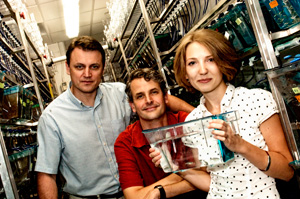Sep 27 2010
Rice physicist Dmitri Lapotko has demonstrated how gold nanoparticles and a laser pulse can detect and destroy diseased cells in living tissue by creating tiny, shiny vapor bubbles that reveal and then explode them.
Now the National Institutes of Health has recognized the potential of Lapotko's inspired technique in the best possible way, by funding further research that holds tremendous potential for the combined diagnostic and therapeutic -- or theranostic -- treatment of cancer and other diseases at the cellular level.
 Researchers based at Rice University and the National Academy of Sciences of Belarus have demonstrated their method to kill cancer cells in vivo with plasmonic nanobubbles. From left: Dmitri Lapotko, Daniel Wagner and Ekaterina Lukianova-Hleb at Rice's zebra-fish lab. JEFF FITLOW
Researchers based at Rice University and the National Academy of Sciences of Belarus have demonstrated their method to kill cancer cells in vivo with plasmonic nanobubbles. From left: Dmitri Lapotko, Daniel Wagner and Ekaterina Lukianova-Hleb at Rice's zebra-fish lab. JEFF FITLOW
Lapotko's Plasmonic Nanobubble Lab, a joint American-Belarusian laboratory for fundamental and biomedical nanophotonics, has received an R01 grant worth more than $1 million over the next four years to continue developing the method to track down individual cancer cells and destroy them in a single process. The procedure employs vapor nanobubbles, which are created when cancer-tracking gold nanoparticles are heated by a pulsed laser.
In earlier research in the Belarus lab, nanobubbles demonstrated their theranostic potential for treating cancer at the cellular level. In another study on cardiovascular applications, plasmonic nanobubbles were filmed blasting their way through arterial plaque. The stronger the laser pulse, the more damaging the explosion when the bubbles burst, making the technique highly tunable.
Lapotko has since studied the effect of plasmonic nanobubble therapy on zebra fish implanted with live human prostate cancer cells and demonstrated the guided ablation of cancer cells in a living organism without damaging the host. Zebra fish are nearly transparent, which makes them ideal for such in vivo research.
In the study reported online earlier this year in the journal Biomaterials, lead researcher Lapotko and an interdisciplinary team from Rice directed antibody-tagged gold nanoparticles into the cancer cells. The team included Dan Wagner, assistant professor of biochemistry and cell biology; Mary “Cindy” Farach-Carson, associate vice provost for research and professor of biochemistry and cell biology; and Jason Hafner, associate professor of physics and astronomy and of chemistry. A short laser pulse overheated the surface of the nanoparticles and evaporated a very thin volume of the surrounding medium to create a small vapor bubble that expanded and collapsed within nanoseconds. This left the cells undamaged but generated an optical scattering signal that was bright enough to detect a single cell in a tissue.
A second, stronger pulse generated larger nanobubbles in the same cell that exploded (or, as the researchers call it, "mechanically ablated") the target cell without damaging surrounding tissue. Scattering of the laser light confirmed the cell destruction.
That the process is mechanical in nature is key, Lapotko said. The nanobubbles avoid the pitfalls of chemo- or radiative therapy that damage healthy tissue as well as tumors.
"It's not a particle that kills the cancer cell, but an event," he said. "We're converting light energy into mechanical energy."
The bubbles, which are highly tunable by varying the strength of the laser pulse, range in size from 50 nanometers to more than 10 micrometers.
The new grant will allow Lapotko and his collaborators to study the biological effects of nanobubbles and then combine their functions into a single sequence that would take a mere microsecond to detect and destroy a cancer cell and confirm the results. "By tuning their size dynamically, we will tune their biological action from noninvasive sensing to localized intracellular drug delivery to selective elimination of specific cells," he said.
"Being a stealth, on-demand probe with tunable function, the plasmonic nanobubble can be applied to all areas of medicine, since the nanobubble mechanism is universal and can be employed for detecting and manipulating specific molecules, or for precise microsurgery."